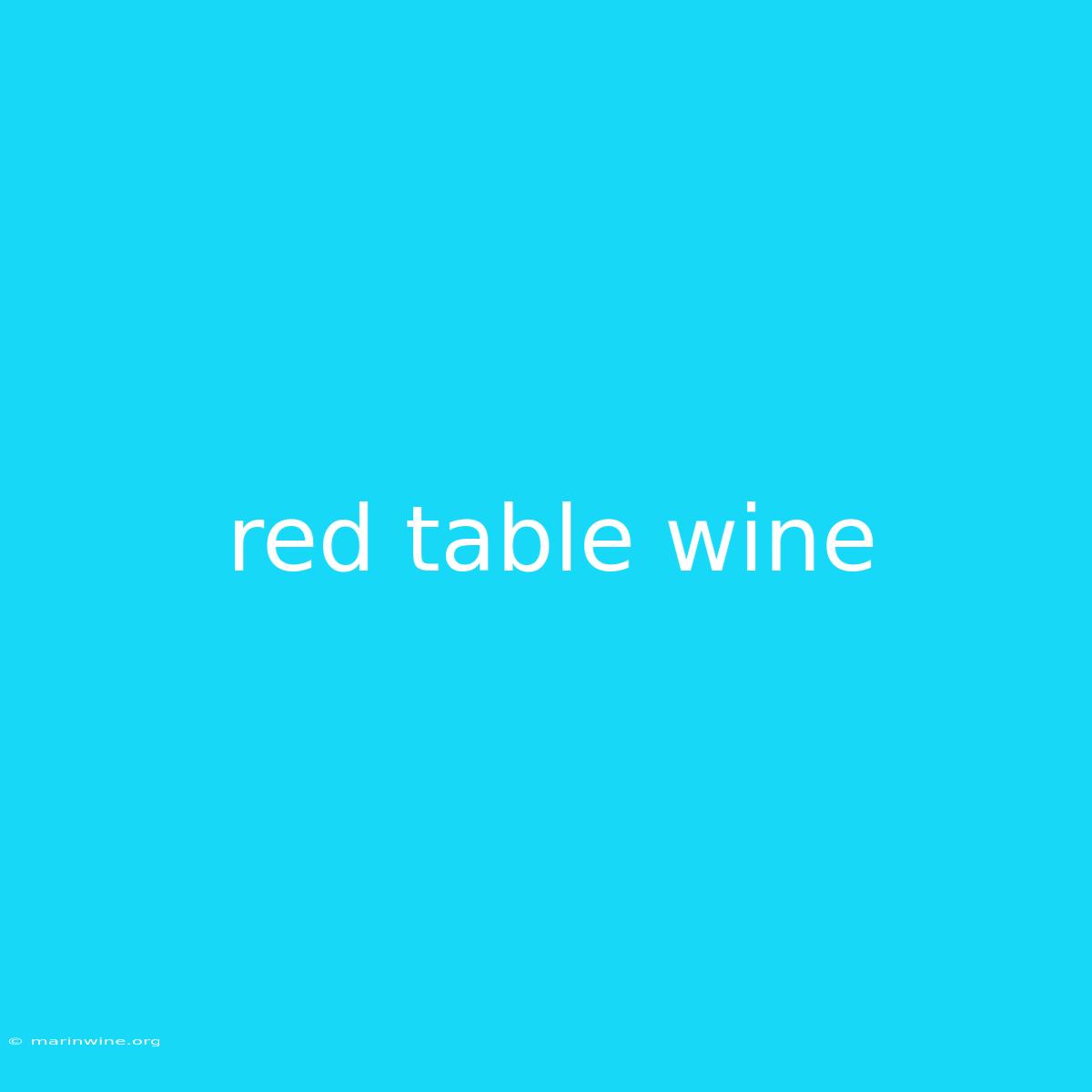Uncorking the Mystery: A Deep Dive into Red Table Wine
Have you ever wondered what makes red table wine so popular? It's not just the rich color and alluring aroma; there's a whole world of complexity and nuance hidden within each bottle. This exploration delves into the fascinating world of red table wine, uncovering its secrets and highlighting its enduring appeal.
Why It Matters: Understanding red table wine goes beyond simply enjoying a glass. This review explores the diverse world of red table wines, encompassing grape varieties, production techniques, and pairing potential.
Key Takeaways:
| Key Aspect | Description |
|---|---|
| Varietal Diversity | Red table wines encompass a wide range of grape varieties, each contributing unique flavor profiles. |
| Production Process | Winemaking techniques, including fermentation and aging, influence the final characteristics of red table wines. |
| Flavor Profile | From fruity and light to bold and complex, red table wines offer a spectrum of flavors. |
| Food Pairing | Red table wines complement a vast array of dishes, enhancing the dining experience. |
Red Table Wine: A Journey of Taste
The world of red table wine is characterized by its diverse and fascinating array of grapes, each offering a unique flavor profile. Popular varieties include Cabernet Sauvignon, Merlot, Pinot Noir, Syrah, and Zinfandel. Cabernet Sauvignon is known for its rich, full-bodied structure and notes of black currant and cedar, while Merlot is smoother with hints of plum and chocolate. Pinot Noir offers a lighter, more delicate experience with notes of cherry and earthy spices. Syrah boasts bold fruit flavors like blackberry and pepper, while Zinfandel presents a fruit-forward profile with hints of jam and spice.
Beyond grape varieties, the production process heavily influences the final characteristics of red table wine. Fermentation plays a crucial role, where yeast converts sugar into alcohol, contributing to the wine's flavor and color. Aging in oak barrels adds further complexity and depth, with notes of vanilla, spice, and toast.
Exploring the Complexities: From Fruit Forward to Earthy
Red table wines exhibit a diverse range of flavors, from fruity and fresh to bold and complex. Younger wines often showcase vibrant fruit flavors, while older wines develop more complex notes of earthiness, spice, and leather.
The style of red table wine can be categorized into different categories based on the intensity of fruit, tannins, and acidity. Full-bodied wines possess a robust structure, often with high tannins and acidity, while medium-bodied wines offer a balance of fruit and structure. Light-bodied wines typically exhibit a lighter, more delicate profile.
Pairing Perfection: Unlocking the Culinary Potential
Red table wines excel at complementing a vast array of dishes, enhancing the dining experience. Their diverse flavor profiles and tannins make them ideal companions to meats, cheese, pasta, and even chocolate.
Here's a glimpse into pairing possibilities:
- Cabernet Sauvignon: Pairs well with grilled steak, lamb, and hearty stews.
- Merlot: Complements roast chicken, salmon, and mushroom dishes.
- Pinot Noir: A versatile pairing with duck, pork, and roasted vegetables.
- Syrah: Enhances flavorful dishes like lamb, game meats, and spicy curries.
- Zinfandel: Pairs well with BBQ ribs, pizza, and spicy sausages.
FAQ: Unraveling Common Questions
What is the difference between red table wine and red wine? While "red table wine" is a general term, "red wine" encompasses a broader category, including dessert wines and fortified wines.
How can I identify a good red table wine? Look for wines with a clear, bright color, an inviting aroma, and a well-balanced flavor profile.
What is the best way to store red table wine? Store red table wine in a cool, dark place, ideally at a temperature between 55°F and 65°F.
How long can I keep a bottle of red table wine? Most red table wines can be stored for several years, with some vintages aging gracefully for decades.
Are there any health benefits to drinking red table wine? Moderate consumption of red table wine has been linked to potential health benefits, including improved heart health.
What are some popular red table wine regions? Bordeaux, Burgundy, Napa Valley, Tuscany, and Rioja are renowned for their exceptional red table wines.
Tips for Choosing and Enjoying Red Table Wine
- Consider your taste preferences: Experiment with different grape varieties and regions to discover your favorites.
- Read wine reviews: Utilize online resources and magazines to gain insights into specific wines.
- Pay attention to the vintage: The year in which a wine was produced can significantly affect its flavor profile.
- Decant your wine: Allowing red table wine to breathe in a decanter can enhance its aroma and flavor.
- Serve at the proper temperature: Red table wines should be served slightly chilled, typically between 60°F and 65°F.
Summary: Uncorking the World of Red Table Wine
This exploration has delved into the captivating world of red table wine, highlighting its diverse grape varieties, production techniques, and flavor profiles. From fruity and fresh to bold and complex, red table wine offers a symphony of tastes, making it an enduring favorite for wine enthusiasts. Whether you're enjoying a casual glass or savoring a special occasion, the allure of red table wine promises an unforgettable experience.

